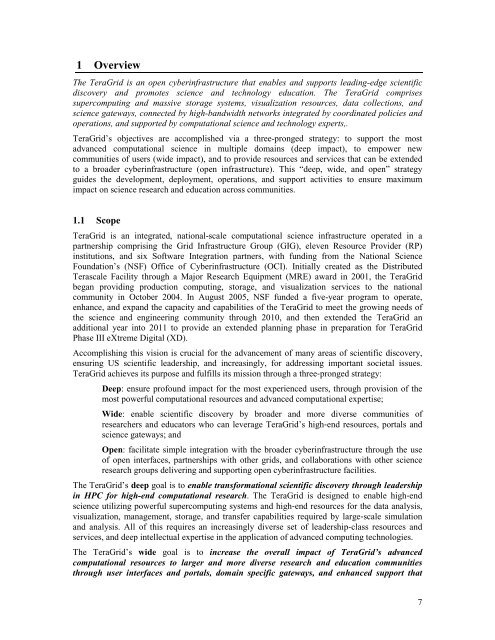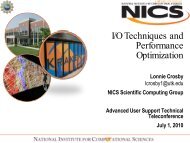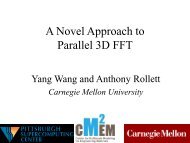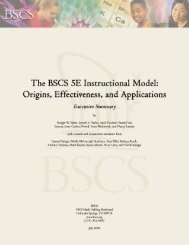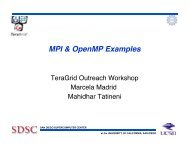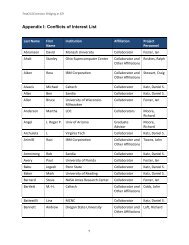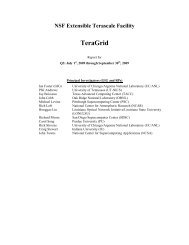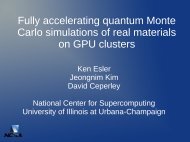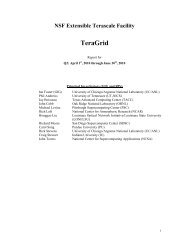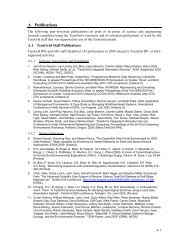TGQR 2010Q4 Report.pdf - Teragridforum.org
TGQR 2010Q4 Report.pdf - Teragridforum.org
TGQR 2010Q4 Report.pdf - Teragridforum.org
Create successful ePaper yourself
Turn your PDF publications into a flip-book with our unique Google optimized e-Paper software.
1 Overview<br />
The TeraGrid is an open cyberinfrastructure that enables and supports leading-edge scientific<br />
discovery and promotes science and technology education. The TeraGrid comprises<br />
supercomputing and massive storage systems, visualization resources, data collections, and<br />
science gateways, connected by high-bandwidth networks integrated by coordinated policies and<br />
operations, and supported by computational science and technology experts,.<br />
TeraGrid’s objectives are accomplished via a three-pronged strategy: to support the most<br />
advanced computational science in multiple domains (deep impact), to empower new<br />
communities of users (wide impact), and to provide resources and services that can be extended<br />
to a broader cyberinfrastructure (open infrastructure). This “deep, wide, and open” strategy<br />
guides the development, deployment, operations, and support activities to ensure maximum<br />
impact on science research and education across communities.<br />
1.1 Scope<br />
TeraGrid is an integrated, national-scale computational science infrastructure operated in a<br />
partnership comprising the Grid Infrastructure Group (GIG), eleven Resource Provider (RP)<br />
institutions, and six Software Integration partners, with funding from the National Science<br />
Foundation’s (NSF) Office of Cyberinfrastructure (OCI). Initially created as the Distributed<br />
Terascale Facility through a Major Research Equipment (MRE) award in 2001, the TeraGrid<br />
began providing production computing, storage, and visualization services to the national<br />
community in October 2004. In August 2005, NSF funded a five-year program to operate,<br />
enhance, and expand the capacity and capabilities of the TeraGrid to meet the growing needs of<br />
the science and engineering community through 2010, and then extended the TeraGrid an<br />
additional year into 2011 to provide an extended planning phase in preparation for TeraGrid<br />
Phase III eXtreme Digital (XD).<br />
Accomplishing this vision is crucial for the advancement of many areas of scientific discovery,<br />
ensuring US scientific leadership, and increasingly, for addressing important societal issues.<br />
TeraGrid achieves its purpose and fulfills its mission through a three-pronged strategy:<br />
Deep: ensure profound impact for the most experienced users, through provision of the<br />
most powerful computational resources and advanced computational expertise;<br />
Wide: enable scientific discovery by broader and more diverse communities of<br />
researchers and educators who can leverage TeraGrid’s high-end resources, portals and<br />
science gateways; and<br />
Open: facilitate simple integration with the broader cyberinfrastructure through the use<br />
of open interfaces, partnerships with other grids, and collaborations with other science<br />
research groups delivering and supporting open cyberinfrastructure facilities.<br />
The TeraGrid’s deep goal is to enable transformational scientific discovery through leadership<br />
in HPC for high-end computational research. The TeraGrid is designed to enable high-end<br />
science utilizing powerful supercomputing systems and high-end resources for the data analysis,<br />
visualization, management, storage, and transfer capabilities required by large-scale simulation<br />
and analysis. All of this requires an increasingly diverse set of leadership-class resources and<br />
services, and deep intellectual expertise in the application of advanced computing technologies.<br />
The TeraGrid’s wide goal is to increase the overall impact of TeraGrid’s advanced<br />
computational resources to larger and more diverse research and education communities<br />
through user interfaces and portals, domain specific gateways, and enhanced support that<br />
7


